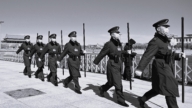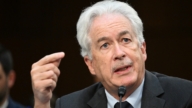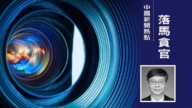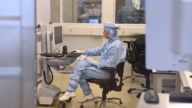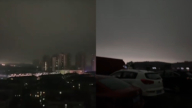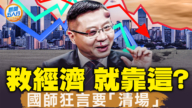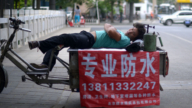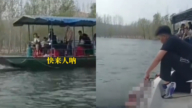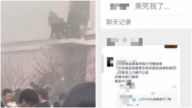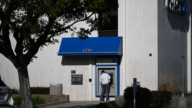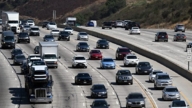【新唐人2013年08月20日訊】未來中國經濟走向如何,成了時下各界關注的焦點。除了「看空中國」、「中國經濟即將崩潰」等觀點,近日,有消息披露,為了避免在三年後背中國經濟危機的「黑鍋」,中共總書記習近平和國務院總理李克強,預計會將中國年度GDP增長降落到3-4%。習李的所謂大動作能挽救中國的經濟危機嗎?我們來看專家的分析。
由於過去幾十年不停的吹泡泡,如今中國經濟已經呈現嚴重的「泡沫化」病態。對於剛上任的李克強,經濟減速已經成為不爭的現實。
第339期的《新紀元週刊》,引述一位北京消息人士獨家披露,習李面臨的難題是,如果繼續刺激經濟,則危機會在三年後出現。到那時,所有的「黑鍋」都將由習李兩人背上。因此他們現在的策略,是讓經濟在今年底或者明年初到達谷底,進入危機狀態。然後通過一系列大動作改革,企圖以此來「挽救經濟危機」。
消息披露,基於這個考慮,習近平贊成李克強的微刺激改結構政策,使得經濟先著陸,再想辦法滑行起飛。內部的消息說,「李克強預計中國年度GDP增長會降落到3-4%。」
臺大經濟系教授張清溪:「中國經濟是充滿著危機,它之所以還可以不發生問題,就是政府它用行政的手段去控制各個問題。這種問題,它當然一時可以掩蓋的住,但是這個事情它一直在惡化,所以終究它會出問題的。」
北京《國情內參》首席研究員鞏勝利指出,中國經濟目前有「三高」,包括政府、能源和企業的成本,都非常高。其中,在政府構架方面,中國是7級,而且是雙重構架。這些成本都要攤到企業頭上。
北京《國情內參》首席研究員鞏勝利:「因為它是黨政運行,從理論上講,它比那些市場經濟法治國家高出來一倍。全球的法治國家裏面,黨是不在所有的政府成本運行中的。而且中國(共)政府的運行,構架特別多。像美國政府,它不超過四級構架。英國、法國、德國,所有的高收入國家,它們的政府運行,都是極低的成本。」
鞏勝利分析,第二大問題,就是中國社會生存和運行的成本很高,比如像水、電、煤、氣,這些人們生活的基本品,成本都很高,這也讓製造業成本低不下來。第三點則是,中國企業的成本高,相應的,中國企業運行的稅收也是最高的。
鞏勝利:「從成本論來講,中國遇到了比較大的麻煩,特別是美國和亞太自由貿易區,還有歐美的(貿易區),今年10月底就要上路,正式運行了。如果這兩個運行後,中國的成本更麻煩更麻煩。因為這兩個自由貿易區最基礎的點是零關稅。零關稅對中國(共)政府的運行是要命的呀。」
鞏勝利進一步指出,中國經濟危機的根源問題,非一日能解決。因為中共既要加強黨的執政能力,又要減少人民和企業運行的成本,這本身就是一對矛盾體。
接近李克強智囊團的消息人士告訴《新紀元》,這次中共的北戴河會議,比以往都更難。因為討論的是一系列的改革措施,據說還有人提出明確的反對意見。
最後這位消息人士還警告說,「如果北戴河不能獲得支持,三中全會將成為習李的滑鐵盧。」
8月10號,中國知名經濟學家郎咸平在上海「錢荒」主題講座上表示,中國經濟正面臨八大危機,包括:產能過剩、通脹、地方政府相繼破產、國企危機、民企危機爆發、銀行、股市、地產等。
郎咸平表示,中共當局五年投資了兩個四萬億,印鈔66萬億,其中國企拿了20萬億,地方政府20萬億,導致嚴重的通貨膨脹,每年的實際通脹20%,全世界最高。
7月29號,《紐約時報》的一篇署名文章表示,「看空中國目前已成為主流觀點,幾乎每天都能看到一篇關於經濟崩潰即將到來的報導。」
採訪/劉惠 編輯/王子琦 後製/李月
The Big Move of China’s New Leaders: Drop GDP Growth
The future of China’s economy has become the focus of many.
On top of the general feeling of “bearishness toward China"
and its economy’s “impending crash,"
it was recently revealed that Chinese Communist Party (CCP)
General Secretary Xi Jinping and Premier Li Keqiang are
expected to drop China’s annual GDP growth to
between 3 and 4%,
in order to avoid taking the blame of
the upcoming economic crisis in three years.
Will Xi and Li’s big move save China from economic crisis?
The continuous economic bubble blowing in the past decades
has led China’s economy into a big bubble problem.
To the new premier Li Keqiang,
economic slowdown has become an indisputable reality.
Issue 339 of The New Epoch Weekly quoted a Beijing inside
source who revealed Xi and Li’s dilemma to the periodical.
That is, if they continue to stimulate the economy,
the crisis will occur in three years and they will take all blame.
So their strategy is to let the economy reach the bottom
at the end of this year or early next year, into a state of crisis.
Then they will have a series of big moves
in an attempt to “save the economic crisis."
The insider says that, based on this consideration, Xi agrees
with Li’s micro-stimulating and structural change policies.
The economy will first land, and then take off.
Internal sources say,
“Li Keqiang expects China’s annual GDP growth fall to 3-4%."
Zhang Qingxi, professor at National Taiwan University’s
Department of Economics: “China’s economy is full of crises.
The government uses its power to control all the issues.
They might be able to cover them up for a while,
but the issues will get worse and will eventually show."
Gong Shengli, Beijing Internal Reference chief researcher,
says the cost of China’s economy is high –
the cost of government, energy and enterprises are all high.
In terms of structure, China’s government has seven
administrative levels, and these are double structures.
These costs are all taken on by enterprises.
Gong Shengli: “The Chinese government includes the
regular governmental operations plus those of the CCP.
In theory, it costs double that of a market economy country.
In western countries, the government doesn’t bear
the expenses of political parties.
The U.S. government has a less than a four level structure.
The governments of all high income countries, such as France,
the U.K. and Germany operate on very low cost."
Gong Shengli says that the second big issue is the high cost
of living in China, such as water, electricity, coal and gas.
The costs of these basic living necessities is very high,
leading to high manufacturing costs.
The third big issue is the high cost of China’s enterprises
and which have the highest taxes.
Gong Shengli: “As for costs, China has run into big problems.
Especially with regard to the Asia Pacific Free Trade Zone and
the Europe-North America Trade Zone that starts in October.
The basis of these free trade zones is no tax.
Zero tax is a key issue to the Chinese government."
Gong Shengli further points out that the fundamental issue
of China’s economic crisis can’t be solved in a day.
For the CCP to strengthen its power
while reducing human and business costs is contradictory.
An insider who is close to Li Keqiang’s think-tank told
The New Epoch that
the CCP’s meeting in Beidaihe this year is harder than ever.
The CCP discussed a series of issues on reform.
The source said that someone raised objections.
The insider also warned that, “If Xi and Li can’t get support
at the Beidaihe meeting,
they will end up in failure at the CCP’s Third Plenary Session."
On August 10, China’s well-known economist, Lang Xianping,
said during his lecture on the “Money Shortage" in Shanghai,
China’s economy is facing eight major crises: inflation,
over-capacity of production, bankrupt local governments,
state-owned enterprises crises, private enterprises crises,
bank, stock market and real estate, etc.
Lang says the CCP authorities invested four trillion yuan
($653 trillion) twice and printed 66 trillion yuan ($10.7 trillion) in the past five years.
Both state-owned enterprises and local governments
got 20 trillion yuan ($3.26 trillion),
leading to serious inflation of 20% each year,
the world’s highest.
On July 29, an article on New York Times reported,
“Bearishness toward China has now gone mainstream,
and rare is the day without a report on the economy’s
impending crash."


